Korean food’s spicy flavor is a hot topic around the world. It has become trendy to film yourself trying Korea’s spiciest concoctions, such as tteokbokki (stir-fried rice cake) and ramyeon (instant noodles). Younger Koreans can’t get enough of spicy food, and foreign visitors are eager to experience Korea’s spicy flavors for themselves, despite teary eyes and runny noses. However, many are probably unaware that Korea’s spicy flavors originate from gochujang (red chili paste). Gochujang is one of many Korean jang (fermented condiments), which acquire their complexity through months of fermenting in the dark in clay pots. Those pots contain the secret ingredient that has propelled Korean food to global fame.
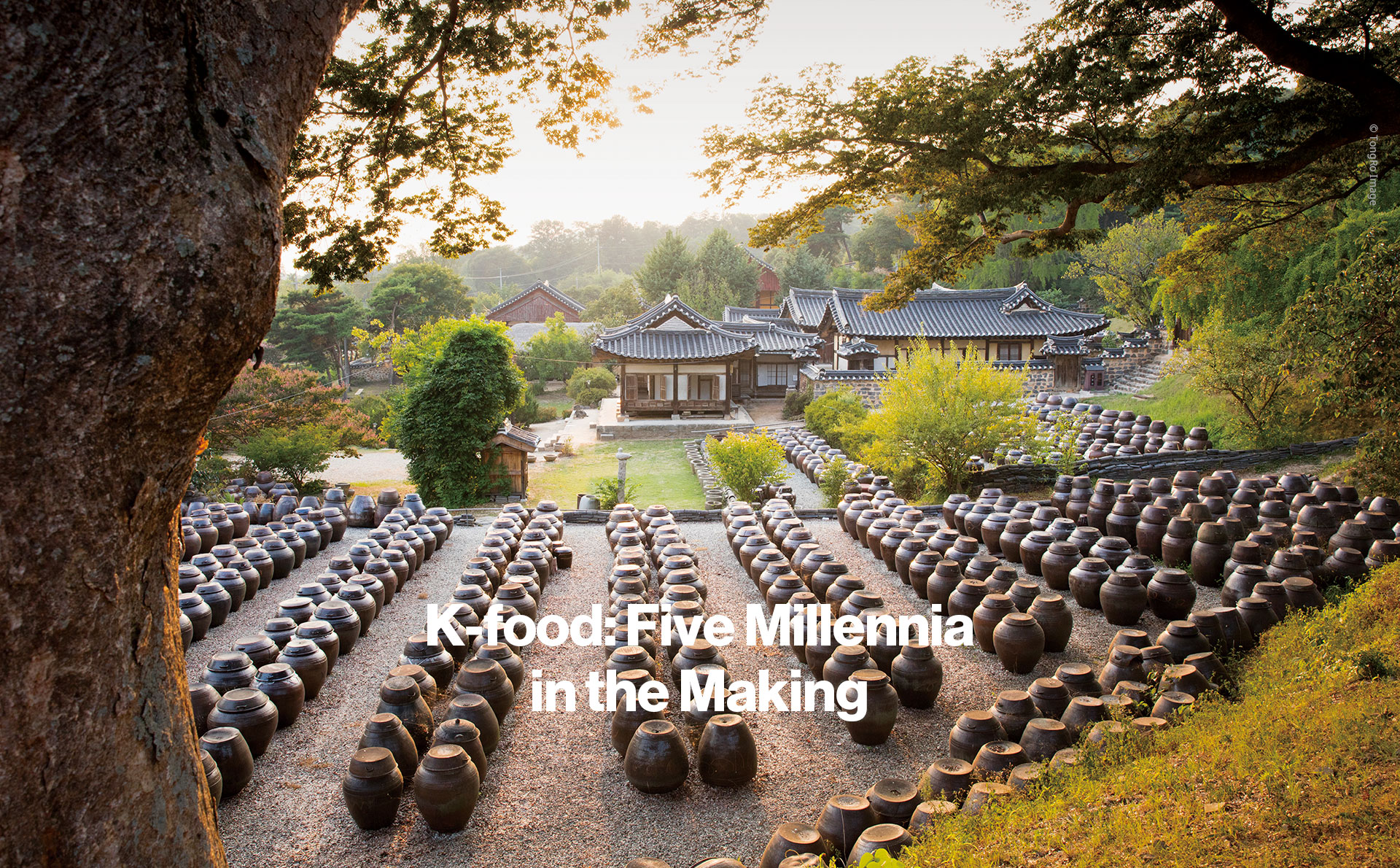
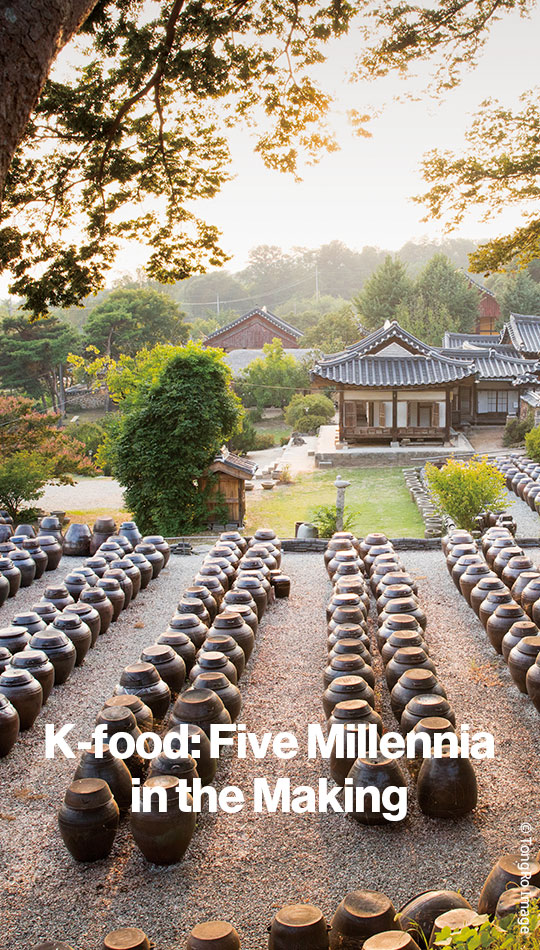
Writer. Lee Joo Hyun
Kood Derives Its Distinctive Spice from Gochujang
One of the non-Koreans’ favorite K-food options is tteokbokki, served in a sweet-and-spicy soup. It’s Korea’s signature snack food, highlighting Gochujang’s authentic flavor without embellishments. Tteokbokki totally depends on the gochujang flavor, and it would be hard to imagine the dish without its defining red chili paste. Gochujang is also an essential element in bibimbap (rice bowl), which is recognized globally as a health food. In that dish, gochujang helps marry the vegetables and meats served atop the rice. Even a small dollop packs a powerful punch, bringing a bowl of bibimbap to perfection.
Korea is the only country making a fermented paste from chili peppers. How did Koreans ever come up with this idea? Back in the days before refrigeration, Koreans dried foods to preserve them longer. Like other vegetables, chili peppers were probably dried in the hot sun. But when all the moisture evaporates from chili peppers, they crumble into dust. That was probably how ancient Koreans learned how to make chili pepper powder. They likely developed the gochujang we know and love today by mixing that powder with various ingredients, just as they did to make doenjang (soybean paste).
Gochujang was developed later than ganjang (soy sauce) and doenjang. The chili pepper isn’t native to the Korean Peninsula; it was introduced after Japan invaded Korea during the Imiin War in the late sixteenth century. Interestingly, the chili pepper has enormously impacted Korean cuisine despite such a late start. It’s even said that the only dishes with staying power were those that went well with chili pepper powder. Koreans like to joke that their fiery tempers are the product of the red-hot chili pepper. For such reasons, gochujang has established itself as an essential seasoning in Korean cuisine.
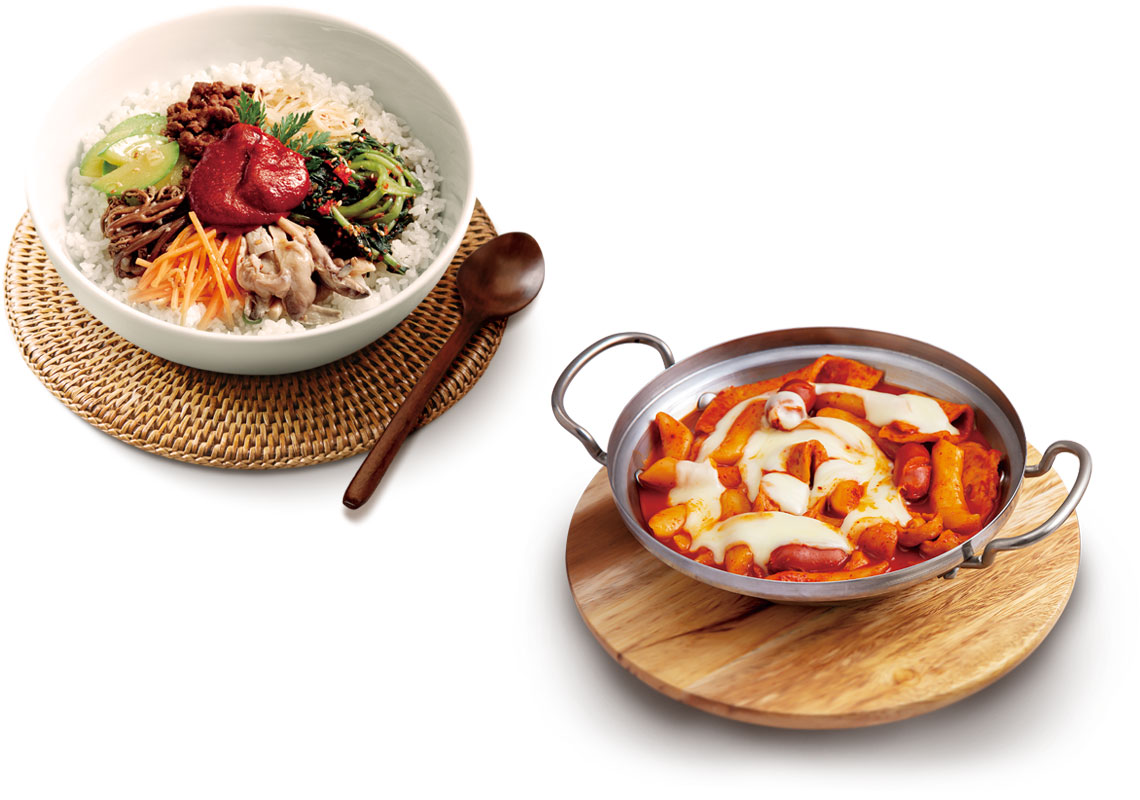 (Left) Bibimbap consists of steamed rice, various vegetables, meat and gochujang, which are mixed together and eaten. © TongRo Image
(Left) Bibimbap consists of steamed rice, various vegetables, meat and gochujang, which are mixed together and eaten. © TongRo Image(Right) Tteokbokki, a delicacy made with tteok (rice cakes), various vegetables and gochujang. © TongRo Image
Gochujang’s Spicy Complexity
The sensation of spiciness has a thousand faces. There are hundreds of fiery spices around the world. Black pepper has a sharp and smoky flavor. That’s why Europeans considered pepper a must-have spice to compensate for meat’s gamey flavor. Another zingy option is mala, which is apt to numb your mouth. It’s a smothering kind of spiciness that nears the threshold of pain. But Tabasco sauce, which is often used in Western cuisine, is marked by a piquant sensation that could be described as light and lively.
How could Korea’s gochujang be described? The paste has a property that distinguishes it from its rivals: it’s just as sweet as it is spicy. Plus, the paste’s sweet side isn’t one-dimensional. It embraces the earthy aroma of the meju (fermented soybean powder) used to make the paste, fruity notes from fermented grain and the zing of the chili pepper. That full-bodied sweetness has an umami that lingers on the tongue. Simply put, gochujang has a complex, spicy flavor with definite overtones of sweetness.
We perceive five basic tastes when we eat: sour, bitter, sweet, spicy and salty. Of the five, sweetness is the most readily perceived. It’s also the most addictive of the basic flavors. This is where we see gochujang’s potential to become a global sauce. There are videos of foreigners who seemingly can’t stop eating tteokbokki despite the intense level of spice. Among other reasons, these diners clearly seem sucked in by gochujang’s intense sweetness. That’s what makes Korean food’s spiciness more addictive than other spicy options around the world
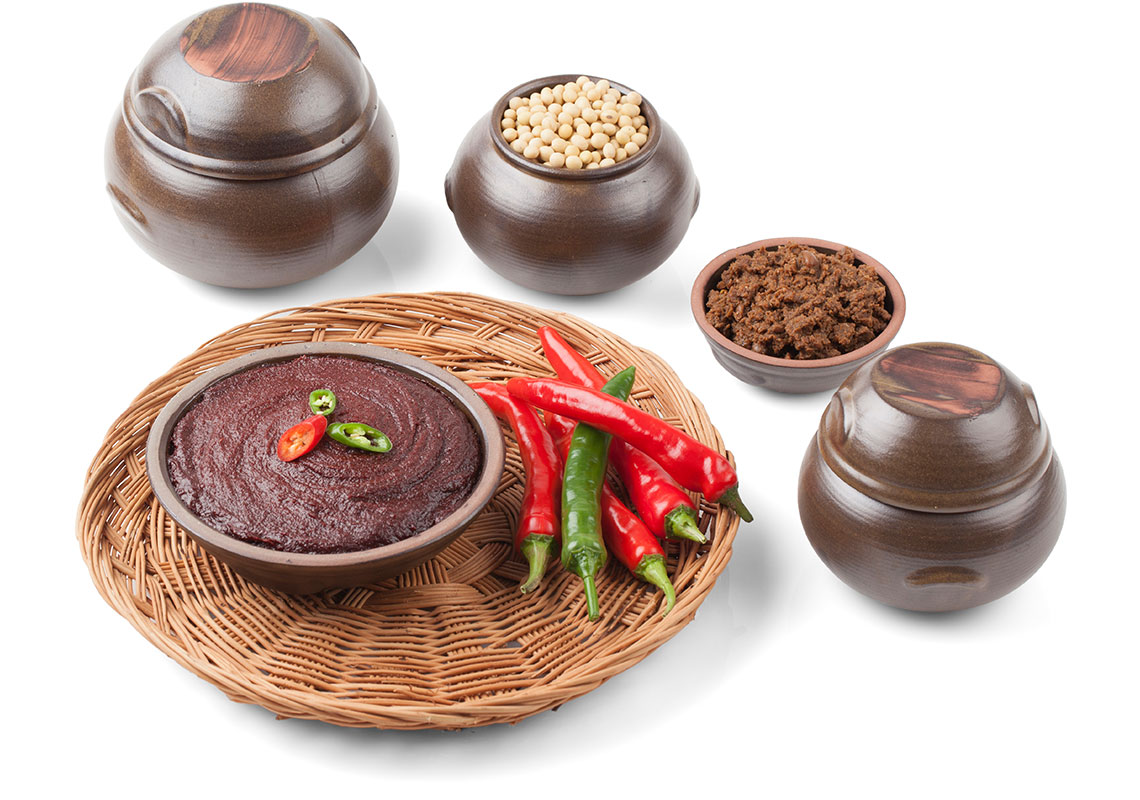 In the center is gochujang, made from red chilies. At the 12 o’clock position are soybeans, which are used to make doenjang. © Gettyimages Korea
In the center is gochujang, made from red chilies. At the 12 o’clock position are soybeans, which are used to make doenjang. © Gettyimages Korea
The Secret Ingredient in Bulgogi
Another Korean delicacy foreign visitors are fond of is bulgogi, or thin cuts of meat marinated in a sweet and salty sauce. Plop a piece of bulgogi on a spoonful of white rice, and prepare yourself for some irresistible umami. Sure enough, bulgogi is a Korean dish that foreigners are almost guaranteed to enjoy. One of the best ways to eat bulgogi is to wrap a marinade-soaked slice of meat in a lettuce leaf. You can’t go wrong with bulgogi’s outstanding umami, which pairs well both with rice and with vegetables.
Bulgogi owes its umami to ganjang, the dish’s defining feature. Along with gochujang, ganjang is one of the cuisine’s best-known fermented condiments, called jang. As you may guess from the name, ganjang, or soy sauce, is made of fermented soybeans. The longer the fermentation, the deeper the flavor of the ganjang. It has a powerful draw that has brought bulgogi to global attention and made it popular with non-Korean diners.
Ganjang is more accessible to foreigners than doenjang. Some people may be thrown off by doenjang’s conspicuous flavor and aroma. But ganjang has less of a pungent aroma, and its flavor is inoffensive as well. For centuries now, Koreans have been seasoning their food not with salt but with ganjang, which has the advantage of adding not only saltiness but also umami. No wonder bulgogi, based on ganjang, has become one of Korea’s signature dishes.
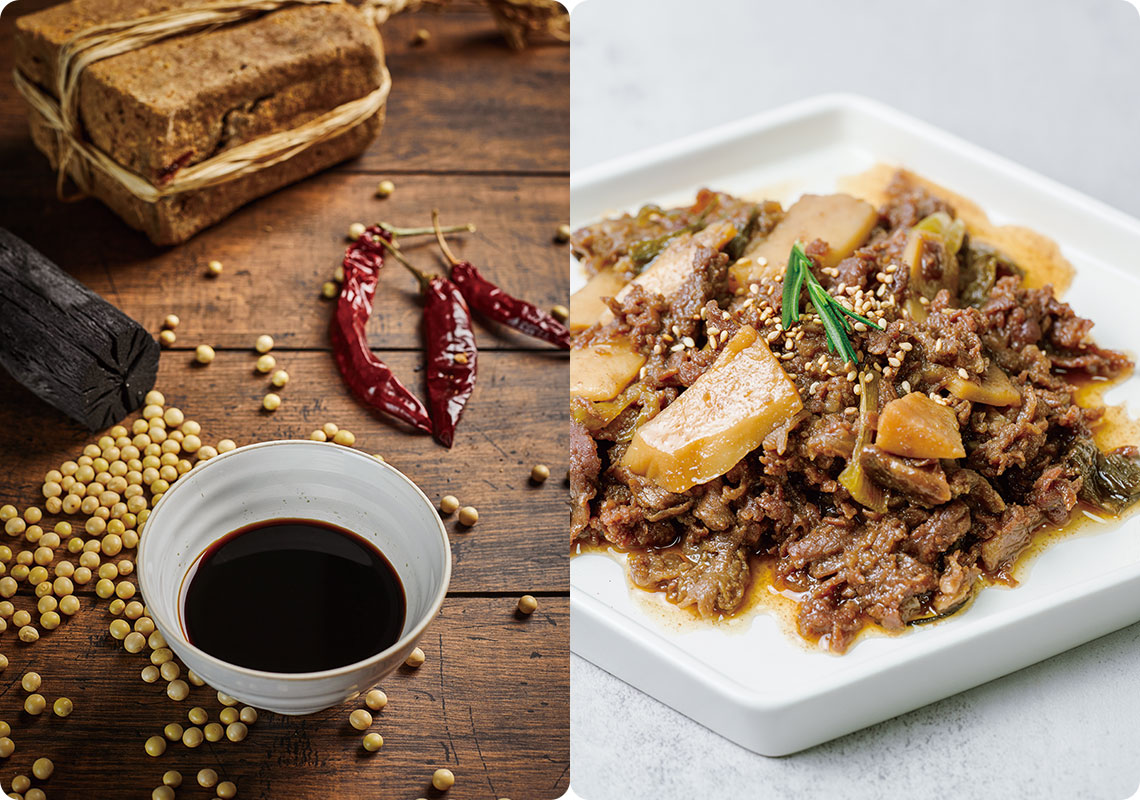 (Left) The main ingredients for making ganjang are meju, soybeans (the ingredient for meju), charcoal and red chilies. © Gettyimages Korea
(Left) The main ingredients for making ganjang are meju, soybeans (the ingredient for meju), charcoal and red chilies. © Gettyimages Korea (Right) Bulgogi, also known as Korean-style barbecue, primarily uses ganjang as the main sauce. © TongRo Image
Jang’s Significance Is Not Only Culinary
Gochujang, ganjang and doenjang are Korea’s best-known fermented foods. Fermentation is a feature of cuisines around the world, ranging from the yeast in leavened bread to cheese and yogurt, both of which are fermented dairy products. Most of the dishes served at our table use gochujang, ganjang or doenjang. It’s challenging to find a Korean dish that doesn’t include them. That includes soups and stews, entrees of all kinds and even Korea’s go-to side dishes. Rarely does a national cuisine feature such a wide range of fermentation applications. Most Korean households stock three critical kinds of jang for seasoning. Jang has constantly evolved throughout five millennia of Korean history, becoming an indispensable component of Korean cuisine today.
In the past, jang was a critical element in the flavor of food. That led Koreans to bestow special meaning on these condiments. In addition to seasoning food, they were regarded as an omen of good fortune or bad luck for the family. It’s understandable when we recall that jang is used in many Korean dishes. When the jang tastes good, all the family’s food tastes good. That naturally leads to better appetites among the family members, keeping them healthier and making them more productive. But when the jang isn’t flavorful, all the dishes taste off, which people thought would lead to poor health for the whole family. There was a certain logic to this attitude, especially at a time when nobody ate out.
Given these factors, Koreans have always taken jang-making very seriously. They were very selective about the day of preparations and even held a ceremony to consecrate the day. There were dozens of rules that had to be religiously followed during the preparations. That gave rise to proverbs such as “Sweet jang brings good luck” and “When the jang’s flavor changes, the family is ruined.” Such proverbs show how highly Koreans valued jang and other kinds of fermented food. Given its close links to daily life, jang came to have an even richer flavor over time while taking on even greater significance for Koreans. The result was a powerful umami for which no other seasoning could substitute. That’s also why gochujang, ganjang and doenjang can be described as the very essence of Korean cuisine. People sometimes say the most unique aspects of Korean culture are the ones with the greatest global appeal. In the end, the reason Korea’s jang-based dishes are tantalizing taste buds around the world is because they retain something so authentically Korean.
Few things are as subjective as taste. A delicacy for one person might be mediocre for another. But the lack of right and wrong answers makes cuisine all the more interesting. There’s no telling what the future may hold. So, what attitude should Korean chefs adopt to promote the globalization of Korean food? The answer is a willingness to try new things constantly. A dish that fails to satisfy some might knock the socks off someone else. I hope that Korean flavors will spread by word of mouth until Korean dining culture is in the global spotlight.

Writer. Lee Joo Hyun
Food Columnist and Culinary Researcher
Lee is a graduate of Le Cordon Bleu and the Department of Food and Nutrition at Sungshin Women’s University, and her work experiences includes stints on a F&B business development team and as a nu-tritionist. She offers a unique perspective on integrating food and humanities in her contributions to various media. Along with her ongoing column titled “Lee Ju-hyeon’s Delicious Culinary Humanitiesr” for the “Hankook Ilbo” newspaper, her excite-ment and expertise can be experienced in various media programs and lectures at universities and libraries.
